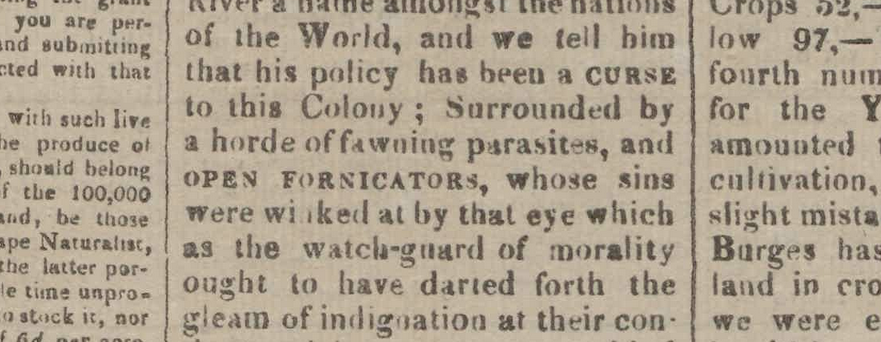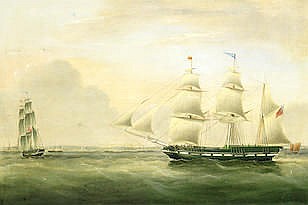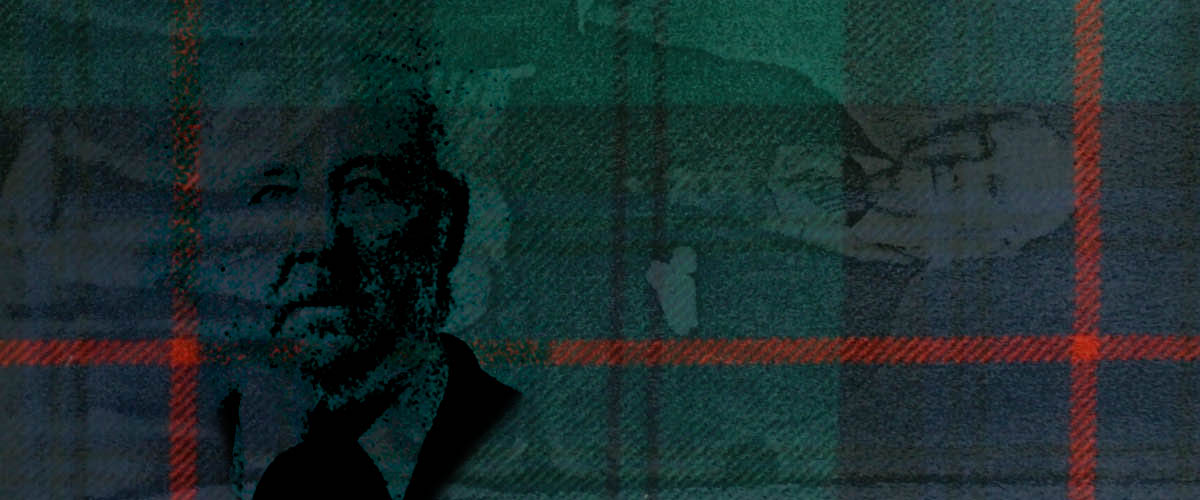The law states that the existence of William Nairne Clark, (1804-1854) lawyer, newspaper editor, and all round ratbag par excellence, must be invoked in any account of Western Australian history being committed to posterity. Once mentioned, any narrative in progress must be brought to a screeching halt so that the digression covering the factoid that William Nairn Clark was involved in the only fatal duel fought in Western Australia’s known history can be regurgitated once more.
That is it. That is Nairn Clark’s Law. Whether the anecdote contains the clarification he survived the encounter, or goes into meticulous detail to relive the event (whether it is relevant to the story being told or not), no writer has ever been able to resist the urge to remind everyone the William Nairn Clark fought the only fatal duel in Western Australia’s colonial history. — As I have so far done, twice.
Now that I have adhered to the letter of the law, allow me to subvert it’s spirit by presenting an early example of Nairn Clark’s Law in action. It is the year 1900 CE. A bunch of newspaper executives are holding a boozy party to celebrate how great they all were before they had to compete with the internet. Then the son of someone who would actually have encountered Nairn Clark all those years ago rose to his feet:—
Mr. H. G. Stirling, in proposing “Success to ‘The Morning Herald,’ ‘Daily News,’ and ‘Inquirer’ Newspapers,’ gave a resume of the history of journalism in Western Australia.
“THE EVENING FUNCTION.” The Inquirer and Commercial News (Perth, WA : 1855 – 1901) 5 October 1900: 5. http://nla.gov.au/nla.news-article67062149.
[…]
The ‘West Australian Gazette’ went along very nicely until 1836, when it had competition in the ‘Western Australian Journal,’ which was published on December 29, 1836. This paper was owned by a pettifogging lawyer, who could do nothing in the law, and so started a newspaper. His name was Mr. William Nairn Clarke. Everything went on very nicely until a woman appeared on the scene. Mr. Clarke and another gentleman, named Johnson, both fell in love with this woman — (laughter) — and it was decided to settle the matter by having a duel, which was fought at a spot near where the Fremantle bridge now stands. Mr. Clarke, like most editors, was successful, and poor Johnson was shot dead. Mr. Clarke cleared off with his lady love, and his father (Mr. Stirling’s) bought the plant, and he believed that some of the type which was bought with the plant was still in “The Morning Herald” office. In the year 1840 his father and Mr. Lochee started the “Inquirer” newspaper, and that paper lived to-day. […]
Every word out of this snivelling scrivener’s mouth was, at best — a bald faced lie, at worst — a half-truth. William Nairn Clark’s newspaper was titled The Swan River Guardian, and operated between 1836 and 1838. However, H. G. Stirling was never one to let a little thing like accuracy get in the way of whatever agenda he was peddling that day, even if it was merely in the cause of embelishing an after-dinner speech. Writing under the by-line of “Hugh Kalyptus”, his extensive writings contaminate much of what we think we understand about our Western Australian past even today.
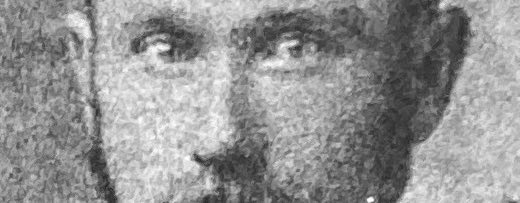
It is worthwhile to read the rest of the vanity article reproduced in one of his own publications to understand how much he would have detested the democratisation of knowledge the potential of the internet grants us, versus the walled garden he then controlled.
By way of contrast, here are a pair of scholarly articles, written in 1929 and 1930, that were researched entirely from primary sources preserved in the official archives. Without this sort of later research becoming reasonably accessible, the metaphorical wheel would have to to be re-invented every time a question is asked, otherwise the easy answer will invariably be Hugh fucking Kalyptus and his ilk. It is best to read these articles in this order:—
(Thank you to Freotopia for this ray of light in an otherwise darkening world)

Bray, F. I. 1930, ‘New light on the Johnson-Clark duel’, Early Days, vol. 1, part 8: 85-86.

Now my statutory duties have been well and truly fulfilled, I can at last proceed to the matter at hand. When W. N. Clarke supported an idea — and he was nothing if not an ideas man — that idea was probably going to be rejected by many solely because it came from him. The Sons of Australia Benefit Society was nearly a victim of the Nairn Clark factor. He made mortal enemies easily. He had a genius for it, in fact. During his earliest years in the Swan River Colony he was deeply involved in the affairs of various merchants and traders who had deep connections with the colony of Van Diemen’s Land. His duel was one manifestation of that connection. Now there is a possibility Nairn Clark also spent some time in that older sister colony before moving to Western Australia. He was certainly never a convict, though perhaps he should have been…
Unfortunately, as with so much W. N. Clark research, My theory is probably based on bullshit.
There’s a lot in this entry that does not stand up to close scrutiny. I will concentrate on the section concerning his last years and death when he did emigrate to Van Diemen’s Land after he had run out of people in the Swan River Colony to antagonise. His death is an easily verifiable fact:—
Similarly, It’s not hard to confirm that William N. Clark did not sail to Van Diemen’s Land on the brigantine Waterlily, but instead on the schooner Bandicoot.
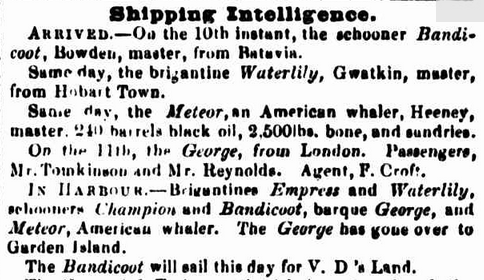

Now that the overall unreliability of this biographical entry has been established, we must turn our attention to the nub of the matter — the date and circumstances of William Nairn Clark’s arrival in the Swan River Colony back in 1830 — as stated in the entry. Or should it 1831? There are two sailing vessels, both named Eliza, that sailed to Fremantle in the Swan River Colony during both those years, but from different directions.
The ship Eliza under the command of Captain Doughty, arrived in Western Australia on 8 May 1830. However, she sailed direct from Hobart-town, Van Diemen’s Land, on 11 April 1830, laden with supplies for the fledgling British outpost. Nairn Clark’s name is not mentioned on the passenger list published in the VDL newspaper.
Alternately the barque Eliza sailed from Gravesend in London on 30 August 1830, but did not arrive at Fremantle until 5 March 1831. Her master was a Captain Weddell (of seal fame). Among the confirmed passengers under Captain Weddell’s charge were both Charles Spyers and Hugh George Smith. Spyers and Smith were both partners in Nairn Clark’s failed fishing experiment on Rottnest Island, the fall out from which would result in the duel with such fatal consequences for one G. F. Johnston. Also on board was the soon-to-be Fremantle Identity Richard McBride Broun, whom Nairn Clark was known to loathe with even more venom than his usual intensity. Six months at sea on a small vessel in close proximity to someone will do that…
This is probably the correct vessel that deposited W.N.C. on Western Australia’s shores, and the entry in the Bicentennial Dictionary is just another typo or error. The barque Eliza does not have a readily accessible passenger list available, if indeed, one exists at all. Yet the list for the alternative is riven with so many coincidences too —
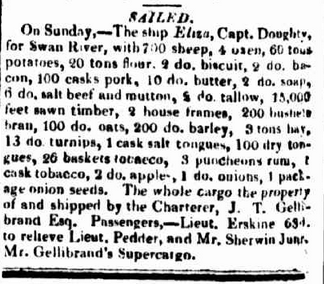
Joseph Tice Gellibrand was a grandee in Van Diemen’s Land. If you’ve been paying attention, you would now know that the man Nairn Clark will soon kill leaves everything to this same Gellibrand in his will. Then there’s the numerous crossing of paths with Mr Sherwin (junior), other VDL associates in Western Australia, and one Wm. N. Clark, esquire.
I don’t know that William Nairn Clark ever did live in VDL before travelling to Western Australia. But if he did, my favourite bastard in Western Australian history (outside the ones I’m actually related to) would be rendered just a little bit more interesting to my eyes. Its possible a bit more data about the barque Eliza might solve this mystery entirely predictably and anti-climatically.
But that’s history too.
Did i mention that William Nairn Clark was involved in the only fatal duel fought in Western Australian history?
